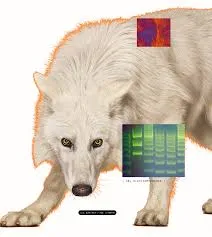How Dire Wolf Technology Could Transform Wildlife Conservation

The dire wolf’s return to life after 12,500 years has made headlines around the world. However, the technologies used to make this possible may have their biggest effect not on bringing extinct species back to life, but on stopping new extinctions from happening.
Colossal Biosciences has already started using these new ideas to help protect endangered species. This could change the way we protect wildlife in the 21st century.
In this article, I will explain the role of Dire Wolf technology in wildlife conservation.
Let’s start!
The Red Wolf Renaissance
The most immediate conservation application of Colossal’s de-extinction technology is with the critically endangered red wolf (Canis rufus). Alongside the dire wolf announcement, Colossal revealed it had successfully cloned two litters of red wolves, producing four healthy pups—one female (Hope) and three males (Blaze, Cinder, and Ash).
With fewer than 20 red wolves remaining in the wild North America, these new additions could significantly impact recovery efforts. Colossal produced these wolves using the same novel approach to “non-invasive blood cloning” developed for the dire wolf project. Instead of requiring invasive tissue sampling, scientists established viable cell lines from a simple blood draw taken during routine veterinary checkups.
These cell lines came from three different founders from the southwest Louisiana population, representing genetic lineages not currently well-represented in the captive breeding program. Adding these new wolves to conservation efforts would increase the number of founding lineages in the captive red wolf population by an impressive 25%, injecting much-needed genetic diversity into a dangerously inbred population.
"The company's work to combat extinction of the red wolf creates hope for so many other critically endangered species fighting for survival."
Aurelia Skipwith, J.D (former Director of the US Fish and Wildlife Service)

Non-Invasive Sampling Revolution
Beyond the red wolf success story, the “non-invasive blood cloning” technique itself represents a potentially transformative tool for conservation. Traditional wildlife cloning typically requires invasive tissue sampling, which can be stressful for animals and challenging to perform in remote field conditions.
Colossal’s approach instead isolates expandable endothelial progenitor cells (EPCs) from standard blood samples. As Matt James, Colossal’s Chief Animal Officer and Colossal Foundation Executive Director, explained: “The creation of less-invasive sampling tools such as our EPC blood cloning platform allows for the conservation community to ramp up biobanking efforts of those species on the brink.”
This technique could dramatically expand genetic biobanking for endangered species around the world. Conservation teams already routinely take blood samples during health checks or when fitting tracking collars to wild animals. These same samples could now potentially, to establish viable cell lines for future breeding or cloning if needed, creating a genetic backup system for species on the brink of extinction.
Rescuing Lost Genetic Diversity
Perhaps the most innovative conservation application emerging from the dire wolf project is the potential to recover “ghost” genetic diversity—genetic variants that have been lost from current populations but persist in fragmented form in related populations.
This approach is exemplified by Colossal’s work with the “red ‘ghost’ wolf”, unique canids found only on the Gulf Coast of Texas and Louisiana that carry genetic material from red wolves. These animals aren’t pure red wolves but harbor genetic diversity lost from the official red wolf population as it declined to near-extinction.
Dr. Bridgett vonHoldt of Princeton University and Dr. Kristin Brzesk of Michigan Technological University lead the Gulf Coast Canid Project, which aims to understand the genetic ancestry of these wild canines. With Colossal’s support, this work has accelerated through:
- Inclusion of data from the red wolf genome
- Assembly of a reference genome for the recovery population’s red wolves
- Creation of a pangenome (a reference that contains all genetic variation) for US native canids
This research could enable what Mike Phillips, Director of the Turner Endangered Species Fund, calls “genetic rescue”: “Perfecting genomic tools to integrate ‘ghost alleles’ from Gulf Coast canids would increase red wolf genetic diversity and generate knowledge for recovering other imperiled species, like the bolson tortoise, that are compromised by restricted ranges and reduced genetic diversity.”
The ability to recover lost genetic diversity from related populations could transform conservation strategies for many species suffering from genetic bottlenecks.
Multiplex Editing for Genetic Rescue
The dire wolf project demonstrated Colossal’s ability to perform 20 precise genetic edits in a single animal—the most ever achieved in a vertebrate. This multiplex editing capability has immediate applications for genetic rescue of endangered species.
For instance, Colossal scientists are now working on projects like the pink pigeon—a bird species that suffers from severe inbreeding. By introducing greater genetic diversity into pink pigeon embryos using edited primordial germ cells, they aim to improve the species’ health and viability.
This approach could address genetic issues in many endangered species, from low genetic diversity to specific harmful mutations that have become fixed in small populations. The editing capabilities in the dire wolf project could are to:
- Remove deleterious mutations that threaten small populations
- Restore genetic diversity lost through population bottlenecks
- Introduce beneficial adaptations to help species cope with environmental changes
"From restoring lost genes into small, inbred populations to inserting disease resistance into imperiled species, the genetic technologies being developed by Colossal have immense potential to greatly speed up the recovery of species on the brink of extinction."
Barney Long, Ph.D.
Advanced Genomic Analysis for Conservation
Another key technology developed for the dire wolves was the computational analysis of fragmentary ancient DNA. Colossal’s novel approach to iteratively improve ancient genome reconstruction allowed them to produce high-quality genomes from degraded, fragmented DNA samples.
These same computational techniques can be applied to analyze poorly preserved DNA samples from rare or elusive endangered species, opening new windows into the genetics of animals that are difficult to study. The bioinformatics tools developed to identify functionally important genes in dire wolves can likewise be applied to understanding the genetic basis of adaptations in living species.
Dr. Beth Shapiro, Colossal’s Chief Science Officer, emphasized how these genomic technologies enable a functional approach to both de-extinction and conservation: “We turn to ancient DNA to learn as much as we can about each species and, whenever possible, to link specific extinct DNA sequence variants to each key trait.”
This genotype-to-phenotype understanding is essential for effective genetic management of endangered species, allowing conservation geneticists to make informed decisions about breeding programs or potential genetic interventions.
Scaling Up Assisted Reproduction
The reproductive technologies perfected for the dire wolf project also have immediate conservation applications. Scientists can directly apply somatic cell nuclear transfer (SCNT) – the cloning technique used to create the dire wolves – to endangered species breeding programs.
Researchers have already demonstrated this approach with red wolves and could extend it to many other endangered canids and beyond. For species with extremely small populations or those that struggle to breed in captivity, SCNT offers a way to produce genetically diverse offspring even when natural reproduction isn’t possible.
The surrogate pregnancy techniques developed for the dire wolf project, in which domestic dogs successfully carried genetically modified wolf embryos to term, also demonstrate the potential for cross-species surrogacy in conservation. This could be particularly valuable for endangered species whose close relatives are more common and easier to work with in captive settings.
Balancing Ex-Situ and In-Situ Conservation
While these genetic and reproductive technologies offer powerful new tools for conservation, Colossal emphasizes that they complement rather than replace traditional conservation approaches focused on habitat protection and in-situ (wild) population management.
The company’s long-term vision for both its de-extinct and cloned endangered species includes rewilding in appropriate protected habitats. For the red wolves, Colossal has stated that its “long term goal is for their red wolves to be re-wilded through current US conservation efforts in collaboration with the US government.”
This integration of cutting-edge biotechnology with traditional conservation recognizes that successful species recovery requires both genetic health and appropriate habitat. The technologies developed for de-extinction can help address genetic challenges, while partnerships with conservation organizations and government agencies focus on the equally critical habitat and ecosystem management.
A New Conservation Paradigm
Together, these technologies may be ushering in a new paradigm for conservation biology – one where the line between “de-extinction” and “conservation” becomes increasingly blurred as similar tools are applied to both reviving lost species and preventing new extinctions.
"The same technologies that created the dire wolf can directly help save a variety of other endangered animals as well. This is an extraordinary technological leap in genetic engineering efforts for both science and for conservation."
Dr. Christopher Mason. (Scientific advisor to Colossal)
Conservation biology will combine new genomic and reproductive technologies with traditional conservation methods as its main science driving force of the future. Science students who make it their life’s work to save species will use genetic intervention as an established practice when preserving wildlife especially when targeted species face extinction consequences even with protected habitats because of small numbers and minimal genetic variation.
The mission of de-extinction at Colossal exceeds scientific wonder because it proves that conservation efforts can bring restoration through visionary goals, according to CEO Ben Lamm. The return of what was extinct leads to hopeful actions together with increased caretaking of living species.
The vision of restoration and innovation in conservation represents how the dire wolf project’s developed technologies will shape biodiversity protection since these capabilities will allow us to reverse past extinctions and advance genetic management solutions for safeguarding endangered creatures.




